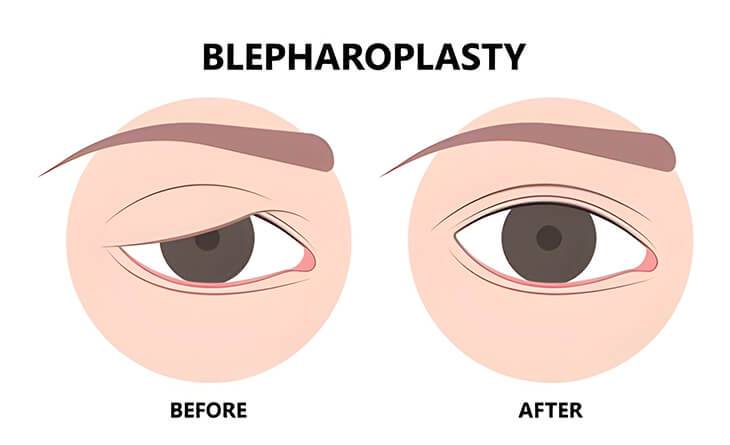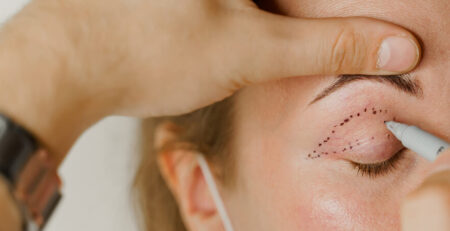Blepharoplasty (Upper & Lower Eyelid Surgery)
Blepharoplasty, often known as eyelid surgery, is an innovative treatment that enhances the look of the eyelids. Whether it’s to rejuvenate aged eyes, improve facial attractiveness, or improve eyesight clouded by drooping eyelids, this procedure provides practical and cosmetic benefits.
But how does it work? Are there any complications related to the procedure? So, many questions, right? But don’t worry! If you are considering blepharoplasty, this comprehensive guide will help you to make an informed decision. Keep reading!
What is Blepharoplasty?
Our skin loses its elasticity with age, leading to the accumulation of excess skin on both the upper and lower eyelids due to age and gravity. Eyelid surgery or blepharoplasty enhances the look around your eyes by removing the puffiness from the lower eyelid and excess skin from the upper eyelid. Blepharoplasty can be applied to either the upper eyelids, the lower eyelids, or both, depending on the individual’s needs.
The blepharoplasty procedure typically involves removing excess skin, muscle, and fat. However, in some cases, these tissues are repositioned to achieve the desired outcome. Although blepharoplasty is primarily used for aesthetic purposes, it can also enhance one’s vision by clearing the visual field of obstructions caused by drooping upper eyelids.
Blepharoplasty helps remove excess fat, but it can’t address dark under-eye circles, crow’s feet, or facial wrinkles. To tackle these concerns, you may require additional surgical or nonsurgical treatments that adjust fat positioning, fill under-eye hollows, or lift the cheeks.

Blepharoplasty Procedure
Eyelid surgery, or blepharoplasty, is a complex procedure that involves the following steps:
Step 1: Preparation
The first and foremost step in the blepharoplasty procedure is preparation, and the preparation of any surgical procedure starts with a consultation with a board-certified plastic surgeon. During this consultation, your surgeon will examine your eye condition, discuss your medical history, and explain the procedure, benefits, and complications. You should provide the information to your surgeon and ask all your questions. Your surgeon will recommend some medical tests. Also, your surgeon will ask you to quit smoking, alcohol or certain medications well before the surgery.
Step 2: Anesthesia
Both upper and lower eyelid surgery is typically performed under local anesthesia with sedation so that you remain comfortable and pain-free throughout the procedure. Also, your surgeon will follow safety protocols and modern surgical techniques for a high success rate and satisfaction.
Step 3: Procedure
Based on your objectives and your surgeon’s advice, eyelid surgery can be performed on the upper eyelids, lower eyelids, or both. Usually, an eyelid blepharoplasty takes 45 minutes to an hour. When both upper and lower eyelids are addressed together, the procedure may extend to approximately two hours, especially if there’s a need for fat repositioning or additional modifications.

Upper Blepharoplasty: In an upper blepharoplasty procedure, your surgeon will create incisions within the natural fold of your upper eyelid, concealing them when your eyes are open. They will then eliminate any surplus skin and prominent fat.
Lower Blepharoplasty: In lower eyelid surgery, the surgeon creates an incision right beneath the lower lash line to eliminate excess skin from the lower eyelid. Additionally, an incision made inside the lower eyelid, known as a transconjunctival incision, may address issues in the lower eyelid by redistributing or excising surplus fat.
Step 4: Incision Closure
After making the required corrections, your surgeon will close the incisions with a suture and apply a bandage for smooth healing. Each of your upper eyelids will have a suture that stays in place for approximately a week. If the incisions are inside your lower lids, stitches won’t be necessary.
Recovery After Blepharoplasty
After upper or lower eyelid surgery, your body needs some time to recover and respond to the modifications made during the procedure. The process differs from person to person but often follows a predictable pattern.
Immediate After Procedure: It is normal to experience swelling, bruising, pain, and discomfort in both your upper and lower eyelids for one week. Your surgeon will prescribe pain management medicines to reduce discomfort and apply cold compresses to minimize swelling. Plan to take some time off work and reduce your activities for a few days post-surgery to give your eyelids time to recover.
First Week: During the first week, your surgeon will remove the stitches in the upper eyelids. You should follow your surgeon’s aftercare instructions, which may include keeping your head elevated and avoiding strenuous activities to ensure optimal healing.
Week 2 to 3: Swelling and bruising will gradually reduce over the next few weeks. Most patients can resume work and routine activities within 10 to 14 days; however, this might vary. It is critical to protect your eyes from sun exposure at this time, and wearing sunglasses when outdoors is recommended.
Long-term Care: Complete recovery and the full surgery results may take many months to show. Scars, if any, will disappear with time, becoming hardly visible. Attending all the follow-up appointments is essential to monitor your progress and address any concerns.
Recovery from upper and lower eyelid surgery requires patience and careful attention to aftercare instructions. By taking the right steps, you can enjoy the rejuvenating effects of the surgery and return to your daily routine with a refreshed appearance. These steps may include:
- Follow your surgeon’s instructions
- Use eye drops as directed to keep your eyes moist and comfortable
- Avoid rubbing your eyes
- Don’t use contact lenses
Risks Related to Blepharoplasty
Although both upper and lower eyelid surgery is the safest procedure, it carries some side effects:
- Bleeding
- Infection
- Dry eyes
- Scarring
- Abnormal darkening on the eyelids
- Eyelid skin folds abnormally in or out
- Inability to fully close the eyes
- Vision loss
However, these side effects are temporary and can be eliminated by choosing a board-certified plastic surgeon, following your surgeon’s instructions and attending all the follow-up appointments.
Book Your Consultation for Your Blepharoplasty!
The success of eyelid surgery significantly depends on the surgeon’s skill and experience. If you are considering upper or lower blepharoplasty to remove puffiness or hooded eyes, schedule your consultation with Dr Lokesh Handa. His expertise can not only ensure desirable aesthetic results but also minimize potential complications.

Dr. Lokesh Handa
M.S, M.Ch
Sr Consultant Plastic, Aesthetic and
Hair Transplant Surgeon
Dr. Lokesh Handa, a board-certified plastic surgeon with over 15 years of experience, holds esteemed titles of M.S. and M.Ch. He serves as a Senior Consultant in Plastic, Aesthetic, and Hair Transplant Surgery.
As the Director of Med Esthetiks, his commitment to excellence is evident. Dr. Lokesh Handa is a distinguished member of renowned organizations, including ISAPS (International Society of Aesthetic Plastic Surgeons), APSI (Association of Plastic Surgeons of India), and IAAPS (Indian Association of Aesthetic Plastic Surgeons). With extensive expertise, he blends precision and artistry, offering unparalleled care in the realm of plastic surgery and contributing significantly to the advancement of aesthetic practices.
To book an appointment, call: +91-8800203431 or email: care@medesthetiks.com











